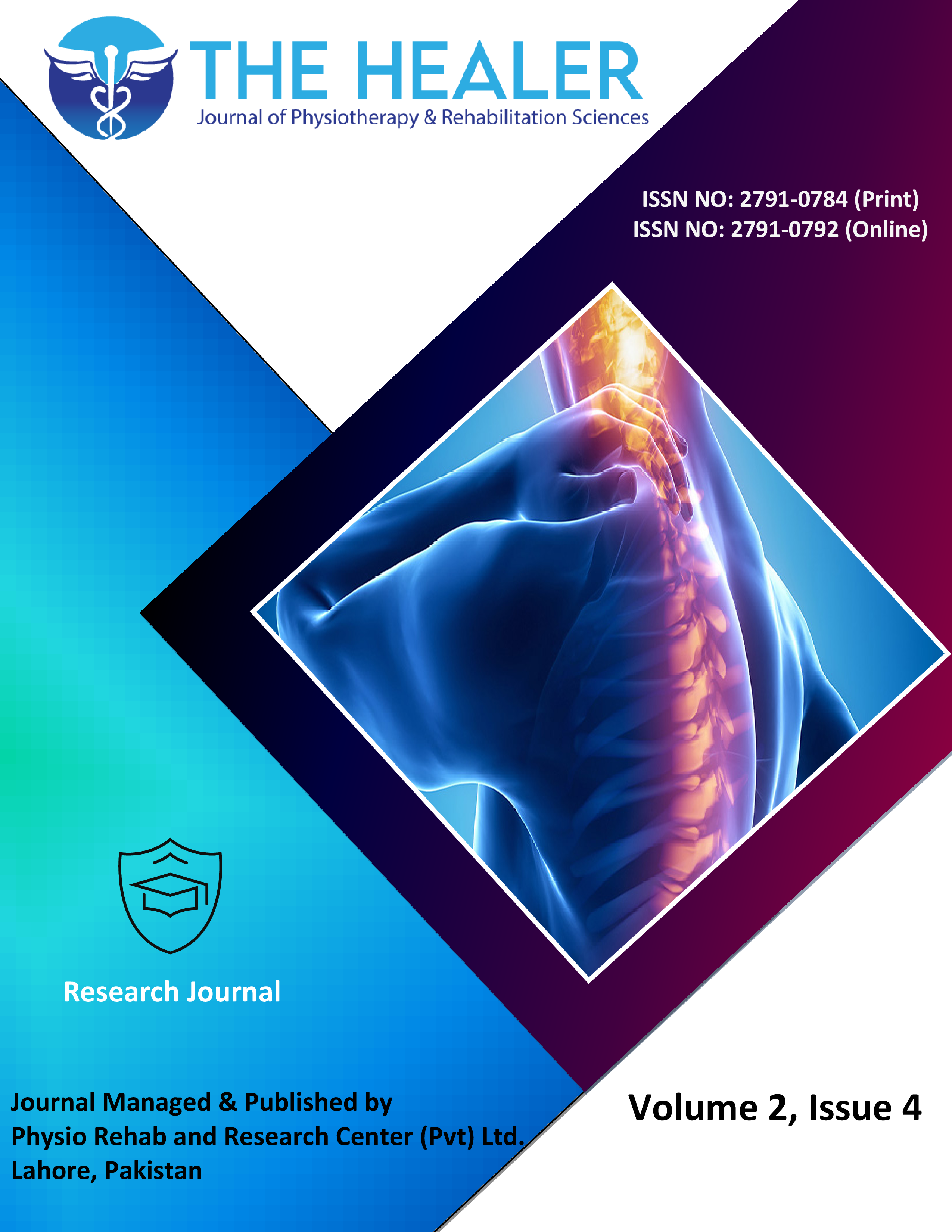Prevalence of Postural Changes During Pregnancy; A Cross-sectional Study
Postural Changes During Pregnancy
DOI:
https://doi.org/10.55735/hjprs.v2i4.70Keywords:
musculoskeletal pain, postural changes, pregnancy, prevalenceAbstract
Background: Pregnant women might experience a lot of physiological and anatomical changes, predominantly postural changes in their bodies. They often report low back pain, leg problems, pelvic girdle pain and urinary incontinence. Pain in the pelvis, lower back and neck might be due to alterations in spinal curvature and postural changes during pregnancy. Anatomical changes occur due to an increase in ligamentous laxity and because of the weight of the fetus during pregnancy. Objective: To estimate the prevalence of postural changes during pregnancy. Methods: This cross-sectional study is approved by the ethical committee of the college in which 113 pregnant women aged between 25 to 45 years were included in the study from different hospitals in Lahore Pakistan, after fulfilling the inclusion criteria using non-probability convenient sampling. Every pregnant woman was given a consent form and after signing that they filled out a questionnaire consisting of questions about their pregnancy, prenatal care, medical problems and pains during the trimester. The pain was rated on a visual analog scale and posture was assessed using a posture score sheet. Although pregnant women who had complications like pre-eclampsia, gestational diabetes, history of trauma, neoplasm or surgery were excluded. For baseline characteristics, percentages and frequencies were calculated. A histogram was plotted for the age variable. Results: In this study, 113 pregnant women with a mean age of 26.3±2.89 years were included. About 24.77% of pregnant females scored poor for lower back postural grading while 20.4% of pregnant females scored poor for upper back postural grading. Conclusion: This study concludes that pregnant females are more likely to develop postural changes during pregnancy due to an increase in ligamentous laxity and weight of the fetus during pregnancy. This study also suggests that the head, shoulder, spine, pelvic and hip posture tilt, head posterior position, lumbar lordosis, lumbar angle and pelvic tilt increases, although the changes and magnitudes of these posture variables are not associated with back pain.
References
Yousef AM, Hanfy HM, Elshamy FF, Awad MA. Postural changes during normal pregnancy. 2011. http://www.americanscience.org.
Kouhkan S, Rahimi A, Ghasemi M, Naimi S, Baghban AA. Postural changes during first pregnancy. British Journal of Medicine and Medical Research 2015; 7(9): 744-53. DOI: 10.9734/BJMMR/2015/16730
Bullock JE, Jull GA, Bullock MI. The relationship of low back pain to postural changes during pregnancy. Australian Journal of Physiotherapy 1987; 33(1): 10-7. https://doi.org/10.1016/S0004-9514(14)60580-8
Gaymer C, Whalley H, Achten J, Vatish M, Costa M. Midfoot plantar pressure significantly increases during late gestation. The Foot 2009; 19(2): 114-6. https://doi.org/10.1016/j.foot.2009.02.001
Gilleard WL, Crosbie J, Smith R. Static trunk posture in sitting and standing during pregnancy and early postpartum. Archives of physical medicine and rehabilitation 2002; 83(12): 1739-44. https://doi.org/10.1053/apmr.2002.36069
Rasheed S, Sameer S. Prevalence of knee pain in post-partum females in Pakistan; A cross-sectional survey. The Healer Journal of Physiotherapy and Rehabilitation Sciences 2022; 2(1): 110-5. https://doi.org/10.55735/thjprs.v2i1.40
Conder R, Zamani R, Akrami M. The biomechanics of pregnancy: A systematic review. Journal of Functional Morphology and Kinesiology 2019; 4(4): 72. https://doi.org/10.3390/jfmk4040072
Wang S-M, DeZinno P, Lin EC, et al. Auricular acupuncture as a treatment for pregnant women who have low back and posterior pelvic pain: a pilot study. American journal of obstetrics and gynecology 2009; 201(3): 271. e1-. e9. https://doi.org/10.1016/j.ajog.2009.04.028
Eger II EI, Saidman LJ, Westhorpe RN. The wondrous story of anesthesia: Springer; 2014.
https://link.springer.com/content/pdf/10.1007/978-1-4614-8441-7.pdf
Franklin ME, Conner-Kerr T. An analysis of posture and back pain in the first and third trimesters of pregnancy. Journal of Orthopaedic & Sports Physical Therapy 1998; 28(3): 133-8. https://www.jospt.org/doi/abs/10.2519/jospt.1998.28.3.133
Le Huec J-C, Saddiki R, Franke J, Rigal J, Aunoble S. Equilibrium of the human body and the gravity line: the basics. European Spine Journal 2011; 20(5): 558-63. DOI 10.1007/s00586-011-1939-7
Biviá-Roig G, Lisón JF, Sánchez-Zuriaga D. Changes in trunk posture and muscle responses in standing during pregnancy and postpartum. Plos one 2018; 13(3): e0194853. https://doi.org/10.1371/journal.pone.0194853
Bullock-Saxton JE. Changes in posture associated with pregnancy and the early post-natal period measured in standing. Physiotherapy theory and practice 1991; 7(2): 103-9.
https://doi.org/10.3109/09593989109106960
Peterson ML, Bertram S, Neelly K, Ausili A, Atterberry B. A comparison of posture and sit-to-stand biomechanics of pregnant women in the third trimester with and without a maternity support: A pilot study. Journal of Women’s Health Physical Therapy 2010; 34(1): 3-9. doi: 10.1097/JWH.0b013e3181d4fbdc
Tanaka MJ, Forman JM, Otwell AG, Frischmann LD, Jones LC, Szymanski LM. Characterization of knee dysfunction and related risk factors during pregnancy. The Physician and Sportsmedicine 2022; 50(1): 78-83. https://doi.org/10.1080/00913847.2021.1882277
Vullo VJ, Richardson JK, Hurvitz EA. Hip, knee, and foot pain during pregnancy and the postpartum period. Journal of family practice 1996; 43(1): 63-9.
Nazar G. Awareness about the role of physical therapy in post-partum females among gynecologists. The Healer Journal of Physiotherapy and Rehabilitation Sciences 2021; 1(1): 21-6. https://doi.org/10.55735/thjprs.v1i1.21
Linjuan W, Yan W, Tan Q, ZHANG M. Review of biomechanical deviations among nonpregnant, pregnant, and postpartum cohorts. Authorea Preprints 2022. DOI: 10.22541/au.165726544.43112462/v1
Chiarotto A, Maxwell LJ, Ostelo RW, Boers M, Tugwell P, Terwee CB. Measurement properties of visual analogue scale, numeric rating scale, and pain severity subscale of the brief pain inventory in patients with low back pain: a systematic review. The journal of pain 2019; 20(3): 245-63. https://doi.org/10.1016/j.jpain.2018.07.009
Rizkya I, Syahputri K, Sari R, Siregar I. Evaluation of work posture and quantification of fatigue by Rapid Entire Body Assessment (REBA). IOP Conference Series: Materials Science and Engineering; 2018: IOP Publishing; 2018. p. 012051. https://iopscience.iop.org/article/10.1088/1757-899X/309/1/012051/meta
Ray-Griffith SL, Wendel MP, Stowe ZN, Magann EF. Chronic pain during pregnancy: a review of the literature. International journal of women's health 2018; 10: 153. doi: 10.2147/IJWH.S151845
Hrvatin I, Rugelj D. Risk factors for accidental falls during pregnancy–a systematic literature review. The Journal of Maternal-Fetal & Neonatal Medicine 2021: 1-10. https://doi.org/10.1080/14767058.2021.1935849
Martínez-Martí F, Ocón-Hernández O, Martínez-García MS, et al. Plantar pressure changes and their relationships with low back pain during pregnancy using instrumented insoles. Journal of Sensors 2019; 2019.
https://doi.org/10.1155/2019/1567584
Okanishi N, Kito N, Akiyama M, Yamamoto M. Spinal curvature and characteristics of postural change in pregnant women. Acta obstetricia et gynecologica Scandinavica 2012; 91(7): 856-61. https://doi.org/10.1111/j.1600-0412.2012.01400.x
Most J, Marlatt KL, Altazan AD, Redman LM. Advances in assessing body composition during pregnancy. European Journal of Clinical Nutrition 2018; 72(5): 645-56. https://www.nature.com/articles/s41430-018-0152-8
Rodacki CL, Fowler NE, Rodacki AL, Birch K. Stature loss and recovery in pregnant women with and without low back pain. Archives of physical medicine and rehabilitation 2003; 84(4): 507-12. https://doi.org/10.1053/apmr.2003.50119
Venter C, Greenhawt M, Meyer RW, et al. EAACI position paper on diet diversity in pregnancy, infancy and childhood: Novel concepts and implications for studies in allergy and asthma. Allergy 2020; 75(3): 497-523. https://doi.org/10.1111/all.14051
Wu W-H, Meijer OG, Uegaki K, et al. Pregnancy-related pelvic girdle pain (PPP), I: Terminology, clinical presentation, and prevalence. European Spine Journal 2004; 13(7): 575-89.
DOI 10.1007/s00586-003-0615-y
Vibe Fersum K, O'Sullivan P, Skouen J, Smith A, Kvåle A. Efficacy of classification‐based cognitive functional therapy in patients with non‐specific chronic low back pain: A randomized controlled trial. European journal of pain 2013; 17(6): 916-28.
https://doi.org/10.1002/j.1532-2149.2012.00252.x
Yousefabadi SR, Sarani A, Arbabshastan ME, Adineh HA, Shahnavazi M. The effect of exercise on back pain and lordosis in the second trimester of pregnancy. Drug Invention Today 2019; 11(9).

Downloads
Published
How to Cite
License
Copyright (c) 2022 The Healer Journal of Physiotherapy and Rehabilitation Sciences

This work is licensed under a Creative Commons Attribution 4.0 International License.
CC BY












